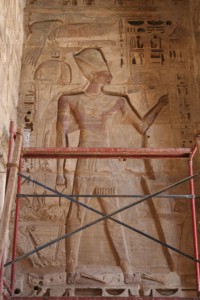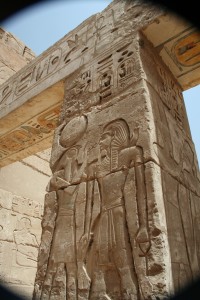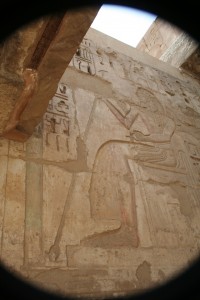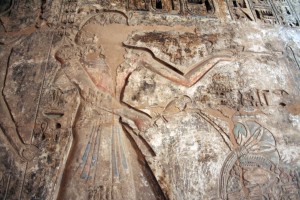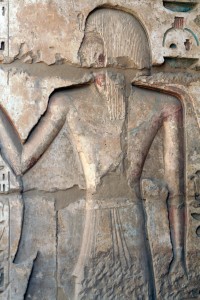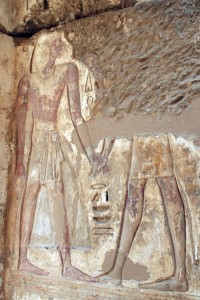The ankh is one of the most universally recognized symbols of ancient Egypt, but there are aspects of its usage that are still obscure. Commonly held by the gods, the ankh is often considered the ‘breath of life’ and had a rejuvenating effect when grasped by the king. One of the reasons that the Art of Counting project exists in the first place is to use statistical methods (from the most basic to the incredibly advanced) to help provide a quantifiable foundation for researching the meaning behind elusive elements such as the ankh.
The king holds an ankh (or ankh-shaped vessel) in his hand in 56 of the 765 scenes at Medinet Habu. Many examples show the king wearing a khepresh (sometimes called the blue) crown (16 times):
or an unadorned nemes headdress (11 times):
Correlation results from Medinet Habu make it clear that it is extremely rare for the king to hold an ankh when he is wearing an atef crown. He is depicted with these two elements only once, in a scene found in the royal mortuary complex where the king sits enshrined (due to its location, this scene is very difficult to photograph):
It is also very uncommon for the ankh to be carried when the king wears a hedjet (also known as the white) crown (only 2 times):
There is a marked preference for the flanking apron (38 times) rather than the multiple apron (9 times) when the king carries an ankh—see here for images of these two types of apron. There are no instances of the shendjet kilt being worn when the king has an ankh in his hand. Below is an image of the king wearing a deshret (red) crown and a shendjet kilt on the pylon at Medinet Habu:
Fifteen of the scenes where he holds an ankh show the king offering to the gods. In eight of these instances, it is an ankh-shaped vessel:
Eighteen of the occurrences depict pharaoh processing (12 of these with humans present). Of the eight scenes found in the four portals that lead from the palace to the first courtyard, an ankh is carried by the king in seven of them–it is only absent from the one scene where he is depicted seated rather than processing:
An ankh is also held in the king’s hand in 13 of the 31 scenes where he is shown in contact with a deity:
This basic analysis, while bringing to light some interesting usage patterns for the ankh, is clearly not enough to provide a definitive answer to its function in these scenes. However, its rare appearance with the atef crown in a rather unusual scene in the royal mortuary complex could serve as a springboard for deeper investigation. Similarly, the offering scenes in which an ankh or an ankh-shaped vessel appear could be more closely examined to determine if there are any unrecognized patterns in their particular usage. For instance, the only example at Medinet Habu of an ankh appearing in combination with a shewty (two-feather) crown is one of those scenes where the king holds an ankh-shaped vessel. With the planned expansion of the database, additional examples from various contexts will allow more complex analyses to be performed. Such analyses could help unlock the mysteries that surround this very well-known element.

